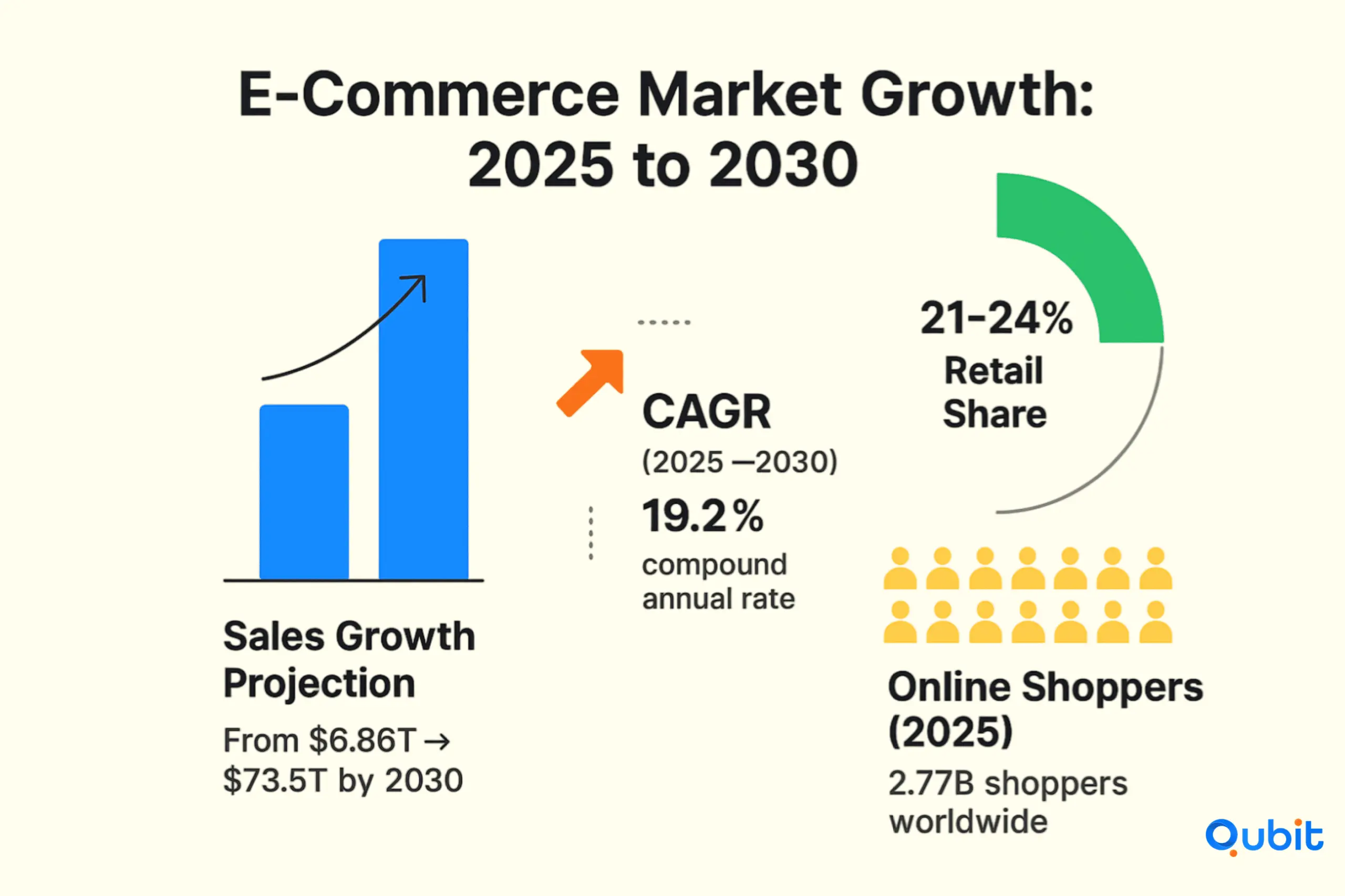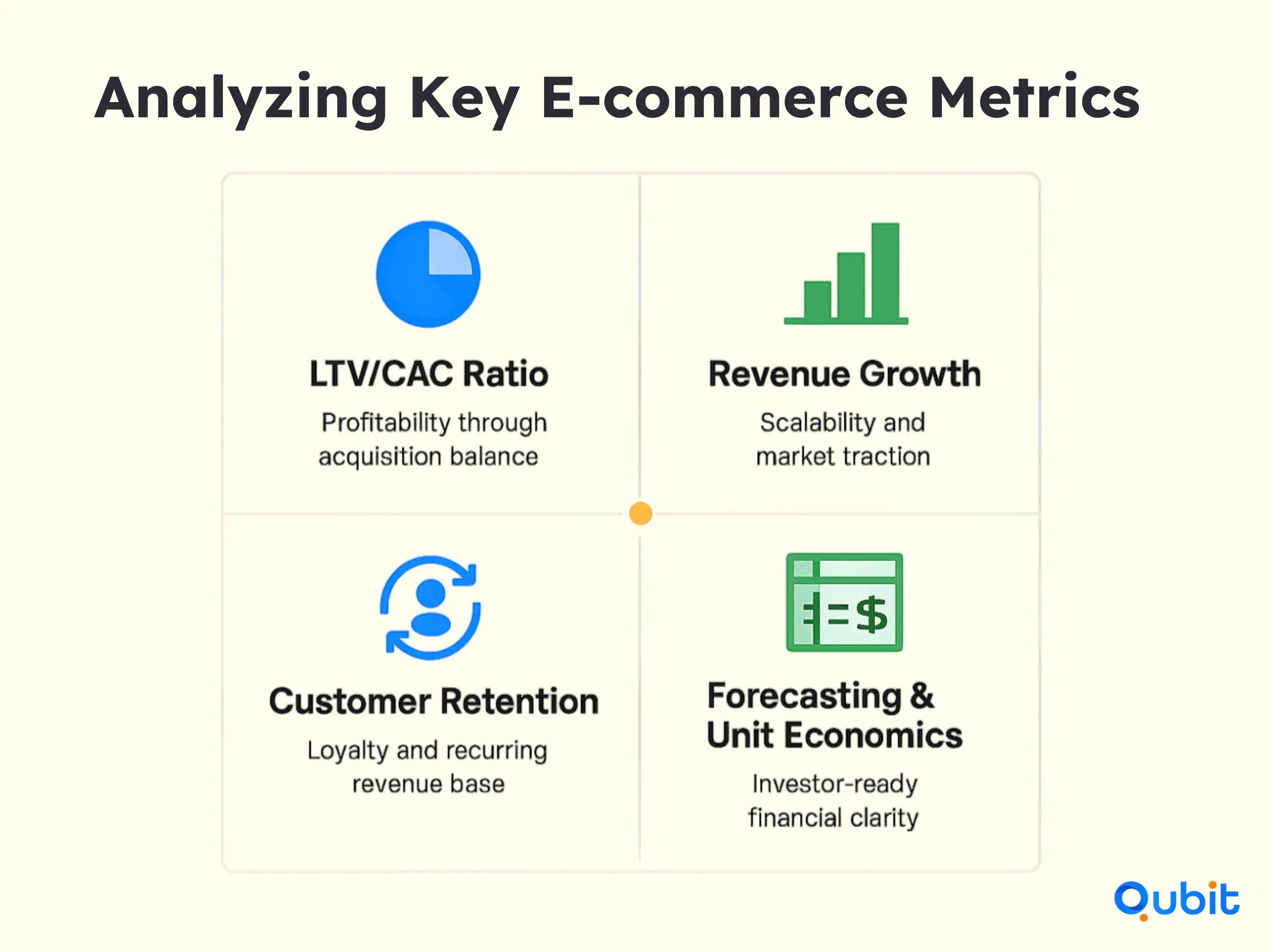Securing funding for your e-commerce start-up begins with understanding the essentials of investment readiness. As the global e-commerce market continues to expand, reaching an estimated $73.47 trillion by 2030, entrepreneurs must position their businesses to attract investors effectively. This article explores actionable strategies to prepare your start-up for funding opportunities, ensuring you stand out in a competitive landscape.
For a concise overview of e-commerce fundamentals you compare different methods such as ecommerce startup fundraising strategies, which provide an extensive overview of financing pathways.
This guide will help you navigate the complexities of e-commerce funding and equip you with the tools to secure investor interest.
Exploring Diverse Growth Opportunities in E-Commerce Funding
E-commerce start-ups aiming to thrive in a competitive market projected to reach $73.47 trillion by 2030. From traditional financing methods to innovative approaches powered by AI and real-time data analytics, entrepreneurs have a wealth of options to consider. This section delves into these diverse funding strategies, emphasizing the importance of clarity in funding terms, robust business planning, and the strategic use of data-driven insights.
The Importance of Business Planning
A clear and comprehensive business plan is essential for securing funding. Investors and lenders need to understand your market strategy, revenue projections, and operational efficiency. Incorporating AI personalization into your business model can further enhance your appeal, showcasing your ability to adapt to evolving consumer demands.
Market Growth and Opportunities

The global e-commerce market is experiencing robust growth, with projections indicating it will reach approximately $73.5 trillion by 2030, growing at a compound annual growth rate (CAGR) of 19.2% from 2025 to 2030. In 2025 alone, global e-commerce sales are expected to hit between $6.86 trillion and $7.4 trillion, accounting for 21–24% of total retail sales worldwide. The number of online shoppers is also rising, with 2.77 billion people (about one-third of the global population) shopping online in 2025.
Key drivers of this growth include:
- The acceleration of online retail adoption following the COVID-19 pandemic
- Increased internet penetration and smartphone adoption
- Advancements in digital payment methods
- The convenience and accessibility of online shopping
Latest Opportunities in E-Commerce
1. Mobile Commerce (M-Commerce)
- Mobile commerce is projected to account for 59% of all retail e-commerce sales in 2025, or about $4.01 trillion.
- The shift to mobile-first shopping experiences presents opportunities for start-ups to innovate in app development, mobile payments, and personalized mobile marketing.
2. Social Commerce
- Social commerce—shopping directly through social media platforms like Instagram and TikTok—is rapidly expanding, simplifying the buyer journey and reducing friction.
- Start-ups can leverage influencer partnerships, live shopping events, and integrated checkout experiences to capture this growing market.
3. AI and Personalization
- Artificial intelligence is enabling hyper-personalized shopping experiences, from product recommendations to chatbots and virtual assistants.
- There is significant potential for start-ups to develop AI-driven solutions that enhance customer engagement and retention.
4. Blockchain and Security
- Blockchain technology is being adopted for secure payments, supply chain transparency, and fraud prevention.
- Start-ups focusing on blockchain applications in e-commerce can address growing concerns around data privacy and transaction security.
5. Sustainability and Eco-Friendly Practices
- Consumer demand for sustainable products and packaging is rising, with 82% of shoppers wanting companies to prioritize people and the planet.
- Start-ups that innovate in sustainable logistics, packaging, and product sourcing can differentiate themselves and tap into this “megatrend.”
6. Cross-Border and Niche Marketplaces
- The value of cross-border e-commerce is surging, providing opportunities for platforms that facilitate international transactions and logistics.
- Niche marketplaces catering to specific interests or demographics are gaining traction as consumers seek curated, community-driven shopping experiences.
Real-time data analytics play a crucial role in these emerging trends. By analyzing customer behavior, inventory metrics, and market conditions, businesses can present compelling cases to investors. Operational insights are further refined when you encounter discussions centered on inventory metrics ecommerce
Attracting Angel Investors for Early-Stage Growth
Angel investors often provide flexible funding terms, but they typically expect a significant equity stake to offset the inherent risks of investing in unproven ventures. This makes it essential for startups to demonstrate their readiness for angel investment by showcasing a strong foundation and potential for growth.
Building a Compelling Case for Angel Investors
Assemble a Strong Team
Angel investors prioritize startups with a capable and cohesive team. Highlighting the expertise, experience, and passion of your team members can instill confidence in investors. A well-rounded team signals the ability to execute your vision effectively, even in challenging circumstances.Show Early Traction
Demonstrating early traction is crucial for attracting angel investors. Metrics such as customer acquisition rates, revenue growth, or user engagement can validate your business model and prove market demand. These indicators reassure investors that their funding will fuel an already promising trajectory.Present an Innovative Value Proposition
A unique and compelling value proposition sets your startup apart from competitors. Clearly articulate how your product or service addresses a specific pain point or fulfills an unmet need in the market. Innovation is often a key factor that motivates angel investors to take the leap.
Balancing Flexibility and Equity
While angel investors are known for their flexible funding terms, they often require a substantial equity stake to mitigate risks. Startups should be prepared to negotiate terms that align with their long-term goals while ensuring the investor feels adequately compensated for their support. Transparency and mutual understanding during these discussions can pave the way for a successful partnership.
Angel investment readiness hinges on demonstrating your startup’s potential for scalability and profitability. By focusing on team strength, early traction, and a standout value proposition, you can position your business as an attractive opportunity for angel investors.
Effective Bootstrapping Strategies for E-Commerce Growth
Bootstrapping an e-commerce startup offers a unique advantage: it allows founders to retain full ownership while fostering organic growth. By relying on personal savings or reinvesting profits, businesses can avoid external funding and focus on efficient operations. However, this approach requires careful planning to overcome the challenges of limited budgets and slower scalability.
Benefits of Bootstrapping
Preserving Ownership
Bootstrapping ensures that founders maintain complete control over their business. Unlike external funding, which often involves giving up equity, this strategy allows entrepreneurs to make decisions without external interference.Encouraging Resourcefulness
Operating with smaller budgets pushes businesses to prioritize efficiency. Bootstrapped startups often excel at identifying cost-effective solutions, streamlining processes, and maximizing the impact of every dollar spent.Fostering Organic Growth
Without the pressure of meeting investor expectations, bootstrapped ventures can focus on sustainable growth. This approach emphasizes building a loyal customer base and refining products or services over time.
Limitations to Consider
While bootstrapping offers significant advantages, it also comes with limitations. Growth may be slower due to restricted financial resources, and scaling operations can become challenging without external capital. Additionally, founders may face increased financial risk, as personal savings are often at stake.
Strategies for Success
To thrive as a bootstrapped e-commerce startup, focus on the following:
- Prioritize Operational Efficiency: Streamline workflows and automate repetitive tasks to save time and money.
- Invest in Organic Marketing: Utilize low-cost strategies like social media engagement, content creation, and email campaigns to attract customers.
- Reinvest Profits Wisely: Allocate earnings to areas that directly impact growth, such as inventory expansion or website optimization.
Bootstrapping may not be the fastest route to success, but it can build a solid foundation for long-term growth. By emphasizing efficiency and organic strategies, e-commerce startups can thrive without sacrificing ownership.
Navigating Traditional Bank Loans for E-Commerce
Securing funding through traditional bank loans remains a reliable option for established e-commerce businesses. These loans often require collateral, such as property or inventory, alongside a strong financial history to demonstrate creditworthiness. For ventures with consistent revenue streams and proven performance, this route can provide the capital needed for expansion or operational improvements.
Banks typically assess several factors before approving a loan. A solid track record of profitability, detailed financial statements, and a clear repayment plan are essential. Collateral plays a pivotal role in mitigating the lender's risk, making it crucial for businesses to have valuable assets to pledge. While the process may be more rigorous compared to alternative financing options, the benefits include lower interest rates and structured repayment terms.
E-commerce businesses with stable revenue can particularly benefit from this approach. For example, a company looking to scale its operations or invest in advanced technology might find bank financing for e-commerce a cost-effective solution. However, it’s important to prepare thoroughly, ensuring all documentation is accurate and the business case is compelling.
Define Key Metrics to Showcase Growth Potential
Investors prioritize data-driven decisions, making it crucial to present clear and measurable metrics that reflect your startup’s potential. Begin by identifying the metrics that matter most for your business model, such as customer acquisition cost (CAC), lifetime value (LTV), and monthly recurring revenue (MRR).
- Track and refine your metrics: Tools like the Gilion AIM Platform can simplify the process of tracking and presenting key metrics. Try Gilion AIM Platform to streamline data presentation in your pitch.
- Highlight industry benchmarks: For instance, 55% of late-stage investments in 2024 exceeded $100 million, as noted in Large Late-Stage Investments. Use such statistics to demonstrate the scope of available capital for scaled e-commerce ventures.
Build a Compelling Pitch Deck
Your pitch deck is the first impression investors will have of your startup. It must be concise, visually engaging, and data-rich to capture their attention.
1. Focus on Your Unique Value Proposition
Clearly articulate what sets your e-commerce business apart. Whether it’s a niche market or an innovative product, emphasize how your startup solves a specific problem.
2. Integrate Accurate Financial Projections
In your pitch deck, combine data from forecasting for an accurate revenue timeline. This demonstrates your ability to plan for sustainable growth.
3. Showcase Case Studies
Include real-world examples to validate your strategy. For instance, the Fashion Marketplace Phased Funding case study highlights how multi-pronged capital structuring, using bank loans for inventory and angel investment for marketing, resulted in 300% monthly revenue growth.
Build Robust Financial Models
Financial transparency is a cornerstone of investor confidence. Presenting detailed and realistic financial models can significantly enhance your credibility.
- Forecast revenue and expenses: Use tools like Gilion Growth Forecasting to create detailed projections that account for seasonal demand, operational costs, and scalability.
- Explore alternative funding options: The Niche Home Décor Grant Utilization case study demonstrates how grants for UX upgrades and invoice financing stabilized inventory during seasonal shifts.
Strengthen Investor Confidence
Transparency and preparation go hand in hand when securing funding. Investors want to see that you’ve considered every aspect of your business, from growth strategies to risk mitigation.
- Present a strategic market entry plan: The discussion of strategic market entry is enhanced when you examine topics like ecommerce go to market plan fundraising, which outlines how targeted market strategies align with growth forecasts.
- Emphasize scalability: Showcase how your startup can adapt to market demands and expand operations without compromising quality or profitability.
By following these steps, you’ll be well-equipped to secure funding for your e-commerce startup and build lasting investor relationships.
Analyzing Key E-Commerce Funding Metrics
Understanding the financial health of an e-commerce business is crucial for attracting investors. Among the most scrutinized metrics are the Lifetime Value to Customer Acquisition Cost (LTV/CAC) ratio, revenue growth, and customer retention rates. These indicators provide a snapshot of profitability, scalability, and long-term viability, making them indispensable in funding discussions.

The Importance of LTV/CAC Ratios
The LTV/CAC ratio is a cornerstone metric that measures how effectively a business turns customer acquisition costs into long-term revenue. A high ratio signals profitability, while a low ratio may indicate inefficiencies in marketing or customer retention strategies.
For deeper insights into expected ratios during early funding rounds, refer to ecommerce LTV CAC benchmarks 2025. This resource offers measurable context for evaluating customer acquisition and retention strategies.
Revenue Growth: A Key Indicator of Scalability
Revenue growth is another critical metric that investors analyze to assess scalability. Consistent growth demonstrates market demand and operational efficiency, while stagnation may raise concerns about the business model. To build investor confidence, ensure your financial models clearly outline growth trajectories and profitability milestones.
Customer Retention: The Foundation of Long-Term Success
Retention rates reveal how well a business fosters loyalty and repeat purchases. High retention rates often correlate with strong brand affinity and customer satisfaction, which are essential for scaling an e-commerce venture.
Clear Unit Economics and Financial Forecasting
Investors value businesses that demonstrate clear unit economics and robust forecasting tools. A detailed financial model, such as the ecommerce unit economics financial model, can clarify how nuanced metrics support investment discussions. This approach not only highlights profitability but also underscores the scalability of your operations.
By focusing on these key funding metrics for e-commerce, businesses can present a compelling case for investment, ensuring their financial strategies align with investor expectations.
Conclusion
Securing startup funding requires a blend of strategic planning and compelling storytelling. Throughout this blog, we’ve explored diverse funding strategies, essential investor metrics, and actionable steps to help founders navigate the complexities of raising capital. A clear, narrative-driven pitch deck paired with robust financial planning can significantly enhance your chances of attracting the right investors.
If you’re looking to turn a clear story and solid metrics into real checks, at Qubit we understand conversion funnels, unit economics, and inventory cash cycles. Raise smarter with our ecommerce fundraising assistance and book a quick strategy call.
Key Takeaways
- Biotech startups face unique dilution challenges due to high capital needs and long development cycles.
- Down rounds can significantly impact valuation, cash flow, and founder ownership.
- Effective governance and strategic exit planning are crucial post-dilution.
- Diverse financing strategies, including non-dilutive options, can help mitigate dilution.
- Real-world examples, such as Zoom’s journey, offer valuable insights for managing dilution.
Frequently asked Questions
What do investors look for in an ecommerce startup?
Investors typically examine unit economics, growth potential, market traction, and the strength of the founding team. A clear business model and financial transparency are also crucial.






